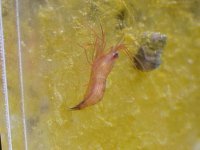Thanks for quick response.
Dave - what's IIRC mean. Don't know that acronym.
This certainly isn't the normal dark green bryopsis or derbesia hair algae I've had to deal with in the past. This yellowish brown stuff is almost gelatinous. No bubbles per se although there are a few strands of other algae currently in the tank with the classic bubbles in them. I think that lighter colored stuff on the algae is really some sand particles. Sorry about the poor pictures (I'm getting better at that - believe it or not

) I had just completed a rock blasting. All the algae is quickly disappearing though with the beefed up janitorial crew.
All water params good as measured with fresh LaMotte test kits.
Ammonia = 0
Nitrite = 0
Nitrate = 0 (very active 5" dsb - many bubbles and worm holes evident )
ph = 8.4 (two meters recently calibrated agree)
temp 77 degrees F
1.024 salinity
Never expected to have an algae outbreak this time round. Link below gives the whole bloody saga. Although dsb and setup this time is about 3 months old, LR is 7 years old, salvaged from my "crashed" reef. Surprisingly there was an awful lot of life that survived on that rock and sand even through the crash.
To get the algae under control, I've been adding to the Astrea heard, also have Nerite, Cerinth, Nessarius, strombus macalatus, for about 1 month.
Running refugium with calerpa on opposite 12 hour photoperiod, dosing 1/2 strength KW for all topoff. All water is RO/DI.
A small "flock" of 6 peppermint were put in about 3 weeks ago. They all disappeared pretty quickly. Now, I know why. The poor guy shown above was a surprise short term survivor. I wondered why he was so bold out in the open during the day.
Circulation in this 125 gallon tank is about 500 gph from the sump with another 500 gph on in tank powerheads controlled by a wavemaker timer. ETS Skimmer is producing reasonable foam, nothing dramatic.
Appreciate all the help. Thanks
Hal
_________________
Chilean Forum





